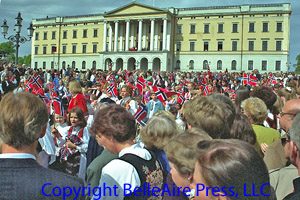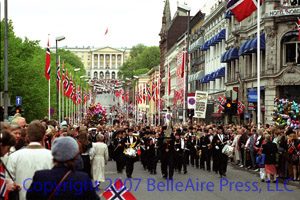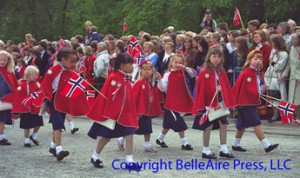Syttendemaitog, Independence Day

Norwegians especially enjoy two major holidays each year. One commemorates their struggle to regain independence as a nation, the other celebrates the Christmas season. Both are family-oriented, combining national festivities and warm, convivial times with their immediate and extended families.
On May 16th of each year, the pace in Oslo begins to quicken.
An international capital of nearly half a million people, Oslo bustles year round. However, on the 16th of May, the city begins to change.
At first the casual visitor might suppose it is due to the arrival of Spring. Winter is over, the trees are glowing with a fresh, brilliant green. Mornings are cool enough for vinter klærne (winter clothes), however, sweaters and windbreakers are off by midday when a few bare arms are seen.
Sunrise is at 6:30 a.m., but dawn occurred two hours earlier. Twilight lasts until 11 p.m. In a few weeks, it will be daylight almost 24 hours a day.
Suddenly, taxi cabs sprout Norwegian flags from their “For Hire” lights on top. Store displays–from hardware to clothing–are bedecked with red, white, and blue ribbons and rosettes.
On the streets, horns suddenly begin honking for no apparent reason. Their drivers don’t seem to be upset, in fact, many are smiling.
Sidewalks are filled with shoppers chatting pleasantly and looking cheerful. They are filling their shopping bags with bread from the bakery, sweet delicacies from the konditori (the bakery specializing in confectioneries), and vegetables from the grønsakshandel (green grocer). From the size of their bags, a great deal of cooking–and eating–will go on tomorrow.
The city doesn’t really settle down during that short night. A surprisingly large number of people are still strolling along the sidewalks when darkness falls at about 11 p.m. Open apartment windows convey frequent laughter and animated discussions in lilting, musical Norwegian. Finally, the city settles down only to begin waking again as dawn arrives at 4:30 a.m.
For much of its history, Norway’s destiny was determined by either Denmark or Sweden.
One result of the Napoleonic Wars in 1813, was the transfer of Norway from Danish to Swedish control.

After Napoleon’s defeat at Leipzig, King Carl Johan of Sweden declared war on Denmark, and eventually took Norway away from the Danes. However, the Swedish diplomats had not consulted the Norwegians about the arrangement. They did not want to be a part of Sweden.
Leaders from throughout Norway gathered at Eidsvoll, a small town about an hour’s drive north of Oslo, and prepared their own Constitution. They even elected the Danish Prince Christian Fredrik as King of Norway.
A short war between Norway and Sweden delayed full independence for nearly a century, however the Swedish government did accept the Norwegian Constitution, which gave the Norwegians the right to have their own Storting (Parliament). The union with Sweden lasted until 1905.
On May 17, 1829, the Norwegians were celebrating what they had come to call Constitution Day. The Swedish authorities were upset. They considered May 17th to be a day of rebellion. In their view, November 4th, the day the union with Sweden was established, was a more appropriate national holiday.
The Swedish governor sent in troops to disperse holiday revelers in the square. Later, it was known as the Battle of Market Square. The “battle” had two important results. From then on, Norway’s governors would be Norwegian. Also, May 17th was firmly established as Norway’s national day of celebration–syttendemai–the 17th of May.
Barnetog
Hours before the barnetog (children’s parade), people start their own parades; groups laughing and talking walk slowly toward Slottet, being observed and appreciated by their countrymen standing patiently along the sidewalks.

High school seniors soon to face their comprehensive examinations prior to graduation are dressed in red “coveralls” with iron-on patches, numbers and slogans. They cavort among the crowds. Many of them toss their calling cards in the air to be caught or picked up by younger children following behind. The calling cards have humorous sayings and are eagerly sought by the younger children who collect them immediately where ever they have fallen.
A roll of drums and the clop of horses hooves on the cobblestones behind the Storting at precisely ten o’clock signal the start of the official parade.
The Oslo Police Department band leads off with mounted patrolmen maneuvering their horses close to the curbs. This encourages the crowds to move back onto the sidewalk–a subtle, but very effective way to create a clear line of march for the parade of bands to come.
The police band is followed by the first of what will be hundreds of bands and marching groups from schools throughout the greater Oslo region. Similar parades and celebrations are being held all over Norway in cities and towns large and small.
Most band members sport medals won in music competitions. The entire front of many a uniform is covered with medals won in music competitions.
Arriving At Slottet With a Lincolnesque flavor, Norway’s Independence Day parade is a parade “of the children, by the children, and for the children.” On they come, one band after another, group after group of marchers, child after child dressed in bunad, flags flying over all, proceeding down Karl Johan, and up the hill to Slottet.
[Note: the letters “et,” at the end of the word slottet replace the English definite article “the.” Thus, et slott, a castle. Slottet, the castle. Flere slott, several castles.]
Turning left as they enter the palace grounds, the seemingly endless parade of people and flags flows up the hill in a clockwise motion. Viewed from atop Karl Johan, the fluttering red, white, and blue flags move steadily through the cheering people creating in effect a colorful national artery. Of course, in a way, with the music rising and the surging procession, it may be just that: enthusiastic and patriotic young people marching toward the slottet are the life’s blood of the nation, they are Norway’s future.
On top of the hill, in front of the palace, each band pauses briefly, in order to give the group ahead of them enough time to pass in front of the palace. Then, leading off with a rattle of drums, they step out smartly to pass in review of the King’s balcony.